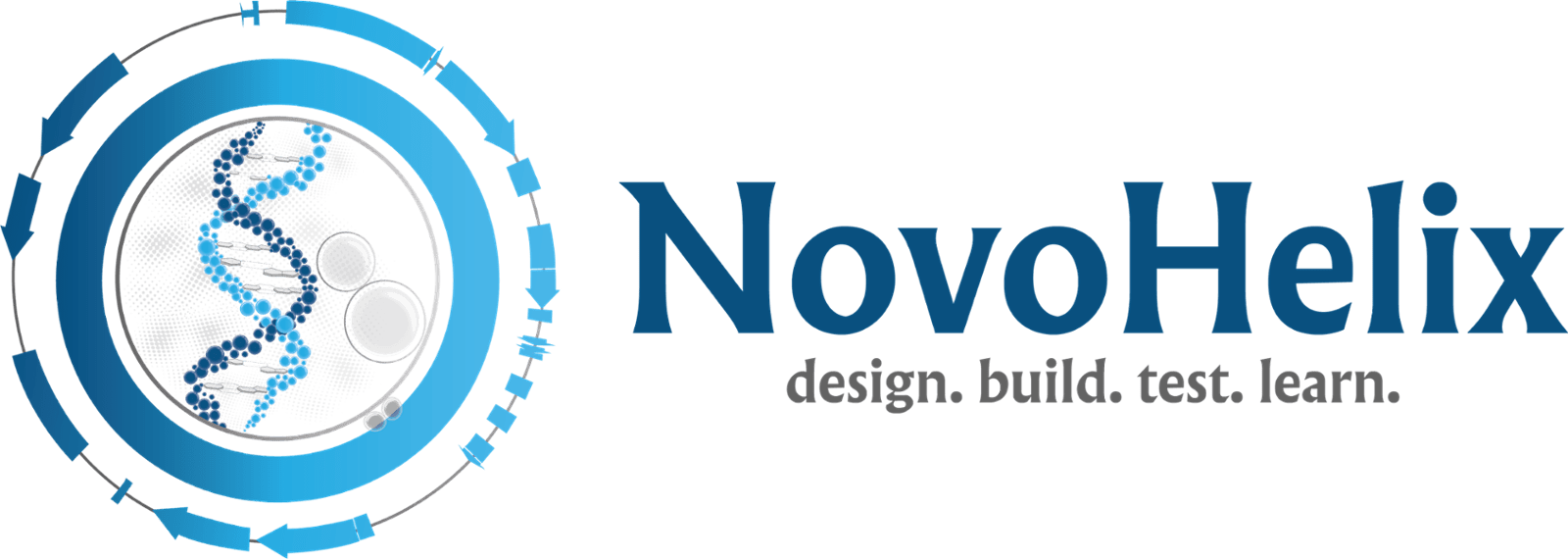O'Connor M, Peifer M, Bender W. Construction of large DNA segments in Escherichia coli. Science. 1989 Jun 16;244(4910):1307-12. PubMed PMID:
2660262.
Yang XW, Model P, Heintz N. Homologous recombination based modification in Escherichia coli and germline transmission in transgenic mice of a bacterial artificial chromosome. Nat Biotechnol. 1997 Sep;15(9):859-65. PubMed PMID: 9306400.
Murphy KC. Use of bacteriophage lambda recombination functions to promote gene replacement in Escherichia coli. J Bacteriol. 1998 Apr;180(8):2063-71. PubMed PMID:
9555887; PubMed Central PMCID:
PMC107131.
Zhang Y, Buchholz F, Muyrers JP, Stewart AF. A new logic for DNA engineering using recombination in Escherichia coli. Nat Genet. 1998 Oct;20(2):123-8. PubMed PMID:
9771703.
Datsenko KA, Wanner BL. One-step inactivation of chromosomal genes in Escherichia coli K-12 using PCR products. Proc Natl Acad Sci U S A. 2000 Jun 6;97(12):6640-5. PubMed PMID:
10829079; PubMed Central PMCID:
PMC18686.
Zhang Y, Muyrers JP, Testa G, Stewart AF. DNA cloning by homologous recombination in Escherichia coli. Nat Biotechnol. 2000 Dec;18(12):1314-7. PubMed PMID: 11101815.
Yu D, Ellis HM, Lee EC, Jenkins NA, Copeland NG, Court DL. An efficient recombination system for chromosome engineering in Escherichia coli. Proc Natl Acad Sci U S A. 2000 May 23;97(11):5978-83. PubMed PMID:
10811905; PubMed Central PMCID:
PMC18544.
Chrast R, Scott HS, Antonarakis SE. Linearization and purification of BAC DNA for the development of transgenic mice. Transgenic Res. 1999 Apr;8(2):147-50. PubMed PMID:
10481314.
Hill F, Benes V, Thomasova D, Stewart AF, Kafatos FC, Ansorge W. BAC trimming: minimizing clone overlaps. Genomics. 2000 Feb 15;64(1):111-3. PubMed PMID: 10708525.
Testa G, Zhang Y, Vintersten K, Benes V, Pijnappel WW, Chambers I, Smith AJ, Smith AG, Stewart AF. Engineering the mouse genome with bacterial artificial chromosomes to create multipurpose alleles. Nat Biotechnol. 2003 Apr;21(4):443-7. Epub 2003 Mar 10. PubMed PMID:
12627172.
Poser I, Sarov M, Hutchins JR, Hériché JK, Toyoda Y, Pozniakovsky A, Weigl D, Nitzsche A, Hegemann B, Bird AW, Pelletier L, Kittler R, Hua S, Naumann R, Augsburg M, Sykora MM, Hofemeister H, Zhang Y, Nasmyth K, White KP, Dietzel S, Mechtler K, Durbin R, Stewart AF, Peters JM, Buchholz F, Hyman AA. BAC TransgeneOmics: a high-throughput method for exploration of protein function in mammals. Nat Methods. 2008 May;5(5):409-15. doi: 10.1038/nmeth.1199. Epub 2008 Apr 6. Erratum in: Nat Methods. 2008 Aug;5(8):748. PubMed PMID:
18391959; PubMed Central PMCID:
PMC2871289.
Ohtsuka M, Kimura M, Tanaka M, Inoko H. Recombinant DNA technologies for construction of precisely designed transgene constructs. Curr Pharm Biotechnol. 2009 Feb;10(2):244-51. Review. PubMed PMID: 19199958.
Rogatcheva MM, Rund LA, Swanson KS, Marron BM, Beever JE, Counter CM, Schook LB. Creating porcine biomedical models through recombineering. Comp Funct Genomics. 2004;5(3):262-7. doi: 10.1002/cfg.404. PubMed PMID:
18629152; PubMed Central PMCID:
PMC2447442.
Warming S, Costantino N, Court DL, Jenkins NA, Copeland NG. Simple and highly efficient BAC recombineering using galK selection. Nucleic Acids Res. 2005 Feb 24;33(4):e36. PubMed PMID:
15731329; PubMed Central PMCID:
PMC549575.
Bird AW, Erler A, Fu J, Hériché JK, Maresca M, Zhang Y, Hyman AA, Stewart AF. High-efficiency counterselection recombineering for site-directed mutagenesis in bacterial artificial chromosomes. Nat Methods. 2011 Dec 4;9(1):103-9. doi: 10.1038/nmeth.1803. PubMed PMID:
22138824.
Chan W, Costantino N, Li R, Lee SC, Su Q, Melvin D, Court DL, Liu P. A recombineering based approach for high-throughput conditional knockout targeting vector construction. Nucleic Acids Res. 2007;35(8):e64. Epub 2007 Apr 10. PubMed PMID: 17426124; PubMed Central PMCID: PMC1885671.
Fu J, Bian X, Hu S, Wang H, Huang F, Seibert PM, Plaza A, Xia L, Müller R, Stewart AF, Zhang Y. Full-length RecE enhances linear-linear homologous recombination and facilitates direct cloning for bioprospecting. Nat Biotechnol. 2012 May;30(5):440-6. doi: 10.1038/nbt.2183. PubMed PMID:
22544021.
Thomason LC, Costantino N, Court DL. Examining a DNA Replication Requirement for Bacteriophage λ Red- and Rac Prophage RecET-Promoted Recombination in Escherichia coli. MBio. 2016 Sep 13;7(5). pii: e01443-16. doi:10.1128/mBio.01443-16. PubMed PMID:
27624131; PubMed Central PMCID:
PMC5021808.
Egbert RG, Rishi HS, Adler BA, McCormick DM, Toro E, Gill RT, Arkin AP. A versatile platform strain for high-fidelity multiplex genome editing. Nucleic Acids Res. 2019 Apr 8;47(6):3244-3256. doi: 10.1093/nar/gkz085. PubMed PMID:
30788501; PubMed Central PMCID:
PMC6451135.
Pines G, Freed EF, Winkler JD, Gill RT. Bacterial Recombineering: Genome Engineering via Phage-Based Homologous Recombination. ACS Synth Biol. 2015 Nov 20;4(11):1176-85. doi: 10.1021/acssynbio.5b00009. Epub 2015 Apr 27. Review. PubMed PMID:
25856528.
Reynolds TS, Gill RT. Quantifying Impact of Chromosome Copy Number on Recombination in Escherichia coli. ACS Synth Biol. 2015 Jul 17;4(7):776-80. doi: 10.1021/sb500338g. Epub 2015 Mar 19. PubMed PMID:
25763604.
Wannier TM, Nyerges A, Kuchwara HM, Czikkely M, Balogh D, Filsinger GT, Borders NC, Gregg Cj, Lajoie MJ, Rios X, Pal C, Church GM. Improved bacterial recombineering by parallelized protein discovery. bioRxiv. 2020 Jan 16. doi: 10.1101/2020.01.14.906594.
Chuang K, Nguyen E, Sergeev Y, Badea TC. Novel Heterotypic Rox Sites for
Combinatorial Dre Recombination Strategies. G3 (Bethesda). 2015 Dec 29;6(3):559-71. doi: 10.1534/g3.115.025841. PubMed PMID: 26715092; PubMed Central PMCID: PMC4777119.
Rondelet A, Pozniakovsky A, Leuschner M, Poser I, Ssykor A, Berlitz J, Schmidt N,
Hyman AA, Bird AW. ESI mutagenesis: A one-step method for introducing point mutations into bacterial artificial chromosome transgenes. bioRiv. doi: 10.1101/844282 Epub 2020 Apr 23. https://www.biorxiv.org/content/10.1101/844282v2
Gregg CJ, Lajoie MJ, Napolitano MG, Mosberg JA, Goodman DB, Aach J, Isaacs FJ,
Church GM. Rational optimization of tolC as a powerful dual selectable marker for genome engineering. Nucleic Acids Res. 2014 Apr;42(7):4779-90. doi: 10.1093/nar/gkt1374. Epub 2014 Jan 22. PubMed PMID: 24452804; PubMed Central PMCID: PMC3985617.
Li XT, Thomason LC, Sawitzke JA, Costantino N, Court DL. Positive and negative
selection using the tetA-sacB cassette: recombineering and P1 transduction in Escherichia coli. Nucleic Acids Res. 2013 Dec;41(22):e204. doi: 10.1093/nar/gkt1075. Epub 2013 Nov 6. PubMed PMID: 24203710; PubMed Central PMCID: PMC3905872.
Wang H, Bian X, Xia L, Ding X, Müller R, Zhang Y, Fu J, Stewart AF. Improved
seamless mutagenesis by recombineering using ccdB for counterselection. Nucleic Acids Res. 2014 Mar;42(5):e37. doi: 10.1093/nar/gkt1339. Epub 2013 Dec 24. PubMed PMID: 24369425; PubMed Central PMCID: PMC3950717.

